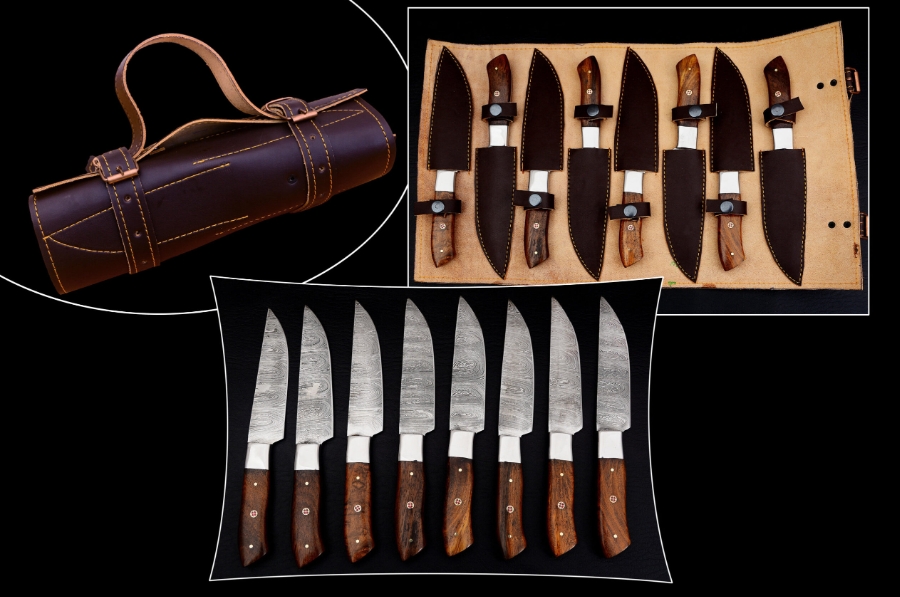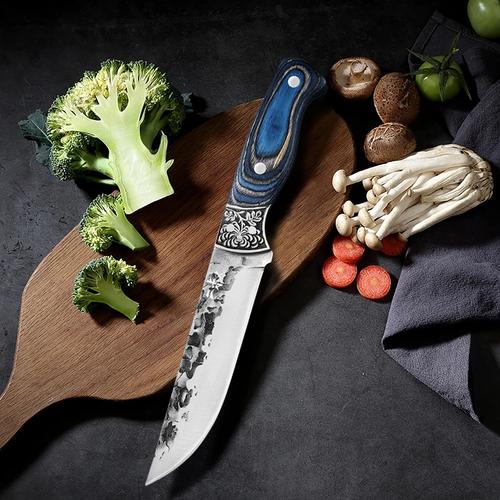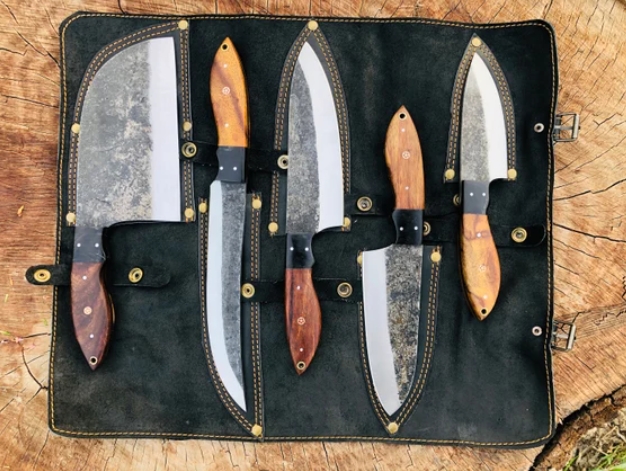

Views: 222 Author: Ella Publish Time: 2025-05-01 Origin: Site








Content Menu
● Understanding Knife Blade Materials
>> Carbon Steel
>> High Carbon Stainless Steel
>> Ceramic
>> Titanium
● Comparing Popular Knife Blade Materials
● Exploring Knife Handle Materials
>> Wood
>> Plastic
>> Metal
>> Micarta and Composite Materials
● How to Match Knife Material to Your Cooking Needs
● Care and Maintenance Tips by Material Type
● FAQ: Top 5 Questions About Knife Materials
>> 1. What is the best material for a kitchen knife blade?
>> 2. Are ceramic knives better than steel knives?
>> 3. How do I care for carbon steel knives to prevent rust?
>> 4. What handle material is most comfortable and durable?
>> 5. Is Damascus steel worth the investment?
Selecting the right material for your knife set is one of the most critical decisions for any home cook or professional chef. The material not only determines the sharpness and longevity of your knives but also affects maintenance, comfort, and even the aesthetics of your kitchen tools. In this comprehensive guide, we'll explore the most popular materials for knife blades and handles, their advantages and disadvantages, and provide visual aids and video resources to help you make an informed choice.

A high-quality knife set is the backbone of any kitchen. But with so many options on the market-each boasting different materials, technologies, and price points-choosing the best set can be overwhelming. The key lies in understanding how blade and handle materials affect performance, durability, and maintenance.
The blade is the heart of any knife. Its material determines how sharp it can get, how long it stays sharp, how easy it is to maintain, and how it responds to different foods and cutting techniques.
Stainless steel is the most common blade material, favored for its corrosion resistance, durability, and ease of maintenance. It's an alloy of iron, carbon, and chromium, which helps prevent rust and discoloration. Stainless steel knives are versatile and suitable for everyday kitchen tasks, but they may require more frequent sharpening than other materials.
Carbon steel knives are prized for their exceptional sharpness and edge retention. They can be sharpened to a finer edge than stainless steel, making them ideal for precision tasks. However, carbon steel is more susceptible to rust and discoloration, requiring diligent care and regular oiling.
High carbon stainless steel combines the best qualities of both stainless and carbon steels. These knives offer excellent edge retention, sharpness, and corrosion resistance, making them a favorite among professional chefs and serious home cooks. They are generally more expensive but require less maintenance than pure carbon steel.
Ceramic blades are extremely hard, lightweight, and maintain their sharpness for a long time. They are also rustproof and do not react with acidic foods. However, ceramic knives are brittle and can chip or break if dropped or misused. They are best reserved for slicing fruits, vegetables, and boneless meats.
Damascus steel is renowned for its beautiful wavy patterns and combines multiple layers of steel for a unique blend of hardness and flexibility. These knives are often high-end, offering excellent sharpness and durability, but they require more maintenance and come at a premium price.
Titanium blades are lightweight, rust-resistant, and non-magnetic. While they are durable and resistant to corrosion, they generally do not hold as sharp an edge as steel knives and are often coated with other materials to improve performance.

| Material | Sharpness | Edge Retention | Corrosion Resistance | Maintenance | Weight | Cost | Best For |
|---|---|---|---|---|---|---|---|
| Stainless Steel | Good | Moderate | Excellent | Low | Medium | $ | Everyday use |
| Carbon Steel | Excellent | Excellent | Poor | High | Medium | $$ | Precision, professionals |
| High Carbon Stainless | Very Good | Very Good | Very Good | Low | Medium | $$$ | Versatile, pros & home |
| Ceramic | Excellent | Excellent | Excellent | Very Low | Light | $$-$$$ | Fruits, veggies |
| Damascus Steel | Excellent | Excellent | Good | Moderate | Medium | $$$$ | Enthusiasts, collectors |
| Titanium | Moderate | Moderate | Excellent | Low | Light | $$-$$$ | Specialty, outdoor |
The handle is just as important as the blade, affecting comfort, grip, balance, and overall safety. Here are the most common handle materials:
Wooden handles offer a classic look and a warm, comfortable grip. They can be crafted from various hardwoods, each with unique grain patterns. However, wood requires regular maintenance and can swell, crack, or harbor bacteria if not cared for properly.
Plastic handles are lightweight, affordable, and resistant to moisture and bacteria. High-quality plastics like polypropylene or ABS are durable, but cheaper plastics may crack or become slippery over time.
Metal handles, commonly stainless steel or aluminum, are highly durable and hygienic. They are easy to clean but can be heavy and may cause hand fatigue during extended use. Some users also find them slippery when wet.
Micarta is a composite material made from layers of linen, canvas, or paper set in resin. It is extremely tough, moisture-resistant, and offers excellent grip, even when wet. Other composites, like G-10 or carbon fiber, provide similar benefits and are often found in high-end knives.
Choosing the right material is not just about the blade or handle in isolation-it's about how the knife will be used in your kitchen.
- Everyday Home Cooking: Stainless steel or high carbon stainless steel offers the best balance of performance and maintenance.
- Professional or Enthusiast: Carbon steel or Damascus steel provides superior sharpness and edge retention but requires more care.
- Lightweight Tasks: Ceramic knives are perfect for fruits and vegetables but should be handled with care.
- Outdoor or Specialty Use: Titanium or composite-handled knives are ideal for their durability and resistance to the elements.
Stainless Steel:
Wash and dry immediately after use. Sharpen regularly with a honing steel or whetstone.
Carbon Steel:
Clean and dry thoroughly after every use. Apply a thin coat of oil to prevent rust. Sharpen frequently.
High Carbon Stainless Steel:
Treat like stainless steel but expect better edge retention. Occasional oiling can prolong life.
Ceramic:
Hand wash only. Avoid dropping or twisting. Sharpen with a diamond sharpener if needed.
Wood Handles:
Hand wash and dry immediately. Apply mineral oil regularly to prevent drying and cracking.
Plastic/Composite Handles:
Dishwasher safe in most cases, but hand washing preserves longevity. Check for cracks or wear.
Metal Handles:
Wipe dry after washing to prevent water spots. Check for slipperiness during use.
Choosing the best material for your knife set is a personal decision that depends on your cooking style, maintenance preferences, and budget. Stainless steel and high carbon stainless steel are excellent all-rounders, offering durability and ease of care. Carbon steel and Damascus steel are perfect for those who value sharpness and are willing to invest time in maintenance. Ceramic and titanium knives serve specialized roles but can be valuable additions to your collection. Don't overlook handle materials, as they significantly impact comfort and safety.
No matter which material you choose, proper care and regular maintenance will ensure your knives remain sharp, safe, and a joy to use for years to come.

The best material depends on your needs. Stainless steel is ideal for most home cooks due to its durability and low maintenance. High carbon stainless steel offers a balance of sharpness and corrosion resistance, while carbon steel is preferred by professionals for its superior edge but requires more care.
Ceramic knives are extremely sharp and lightweight, making them excellent for slicing fruits and vegetables. However, they are brittle and can chip or break easily, so they are not as versatile or durable as steel knives for general kitchen use.
Wash and dry carbon steel knives immediately after use. Store them in a dry place and apply a thin layer of food-safe mineral oil to the blade regularly. Avoid leaving them in damp environments or soaking in water.
Micarta and other composite materials offer excellent grip, durability, and moisture resistance. Wood handles are comfortable and attractive but require more maintenance, while plastic and metal handles are easy to clean and durable.
Damascus steel knives are known for their beauty, sharpness, and edge retention. They are often more expensive and require regular maintenance, but many chefs and enthusiasts find them worth the investment for their performance and aesthetics.